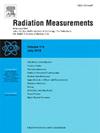Performance assessment of ionization chambers in standard diagnostic radiology beams through the determination of calibration coefficients
IF 1.6
3区 物理与天体物理
Q2 NUCLEAR SCIENCE & TECHNOLOGY
引用次数: 0
Abstract
Dosimetry laboratories use reference ionization chambers (ICs) as their primary instruments for measuring radiation doses. The ICs are designed to have defined and accurate response characteristics, making them suitable for calibrating radiation detectors in specific beam qualities. This study assesses six ionization chambers (Radcal 10X6-3CT, Radcal 10X6-M, Radcal 10X6-10, Radcal 10X6-6, Exradin A4, and FC-65-G1) in standard International Electrotechnical Commission (IEC) defined diagnostic beams [RQR, RQA, RQT, and RQR-M (W + Al)] at the Secondary Standard Dosimetry Laboratory (SSDL). Calibration coefficients were estimated to evaluate energy dependency and relative response deviations of the ICs. Results showed that most ICs tested had limited energy dependency in RQR, RQA, and RQT beams, with deviations under 5%, confirming their suitability for clinical dosimetry and reference calibration at the SSDL. The Radcal 10X6-M performed well in mammography beams, while the other ICs showed significant deviations (6%–107%) in RQR-M (W + Al), limiting their mammography use. A key finding is the extended applicability of certain ICs beyond their specified energy ranges, particularly the Radcal 10X6-3CT, Radcal 10X6-M, and Radcal 10X6-10, which performed well in a broader range of diagnostic beam energies. This study provides essential data for optimizing IC selection and calibration, and highlights the need for further development of energy-independent ICs for enhanced versatility across clinical settings.
通过校准系数的测定对标准诊断放射光束中电离室的性能进行评估
剂量测定实验室使用参考电离室(ic)作为测量辐射剂量的主要仪器。集成电路的设计具有明确和准确的响应特性,使其适用于校准特定光束质量的辐射探测器。本研究评估了二级标准剂量测定实验室(SSDL)标准国际电工委员会(IEC)定义的诊断光束[RQR, RQA, RQT和RQR- m (W + Al)]中的六个电离室(Radcal 10X6-3CT, Radcal 10X6-M, Radcal 10X6-10, Radcal 10X6-6, Exradin A4和FC-65-G1)。估计校准系数以评估ic的能量依赖性和相对响应偏差。结果显示,大多数测试的ic在RQR、RQA和RQT光束中具有有限的能量依赖,偏差小于5%,证实了它们在SSDL的临床剂量学和参考校准中的适用性。Radcal 10X6-M在乳房x线摄影光束中表现良好,而其他ic在RQR-M (W + Al)中表现出显著偏差(6%-107%),限制了其乳房x线摄影的使用。一个重要的发现是某些集成电路在其指定能量范围之外的扩展适用性,特别是Radcal 10X6-3CT, Radcal 10X6-M和Radcal 10X6-10,它们在更广泛的诊断光束能量范围内表现良好。这项研究为优化IC的选择和校准提供了必要的数据,并强调了进一步开发能量独立IC以增强临床环境通用性的必要性。
本文章由计算机程序翻译,如有差异,请以英文原文为准。
求助全文
约1分钟内获得全文
求助全文
来源期刊

Radiation Measurements
工程技术-核科学技术
CiteScore
4.10
自引率
20.00%
发文量
116
审稿时长
48 days
期刊介绍:
The journal seeks to publish papers that present advances in the following areas: spontaneous and stimulated luminescence (including scintillating materials, thermoluminescence, and optically stimulated luminescence); electron spin resonance of natural and synthetic materials; the physics, design and performance of radiation measurements (including computational modelling such as electronic transport simulations); the novel basic aspects of radiation measurement in medical physics. Studies of energy-transfer phenomena, track physics and microdosimetry are also of interest to the journal.
Applications relevant to the journal, particularly where they present novel detection techniques, novel analytical approaches or novel materials, include: personal dosimetry (including dosimetric quantities, active/electronic and passive monitoring techniques for photon, neutron and charged-particle exposures); environmental dosimetry (including methodological advances and predictive models related to radon, but generally excluding local survey results of radon where the main aim is to establish the radiation risk to populations); cosmic and high-energy radiation measurements (including dosimetry, space radiation effects, and single event upsets); dosimetry-based archaeological and Quaternary dating; dosimetry-based approaches to thermochronometry; accident and retrospective dosimetry (including activation detectors), and dosimetry and measurements related to medical applications.
 求助内容:
求助内容: 应助结果提醒方式:
应助结果提醒方式:


